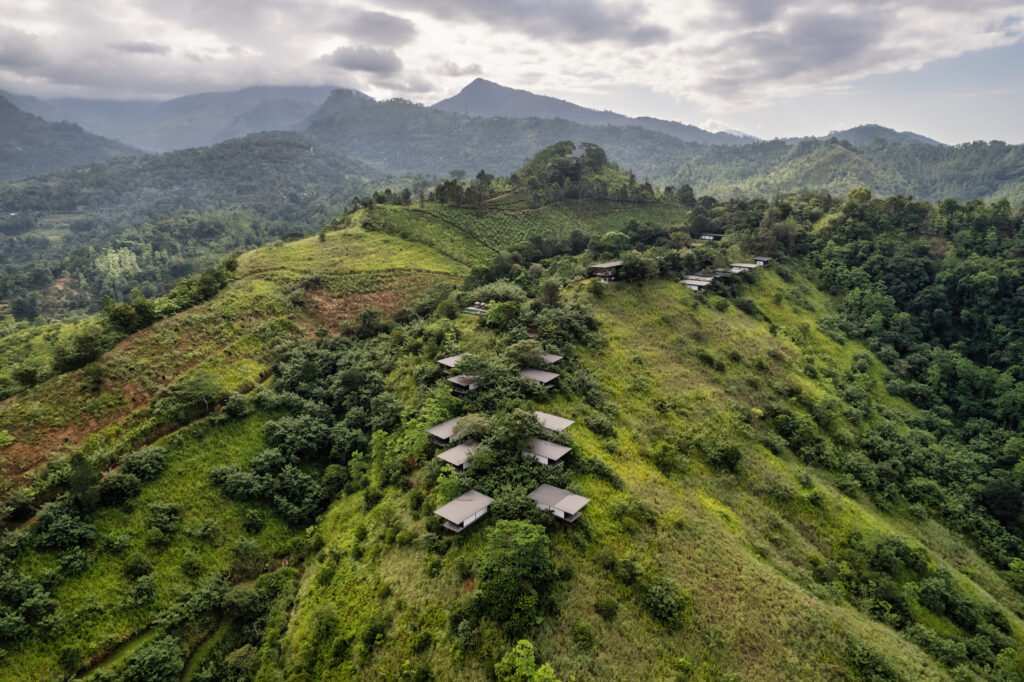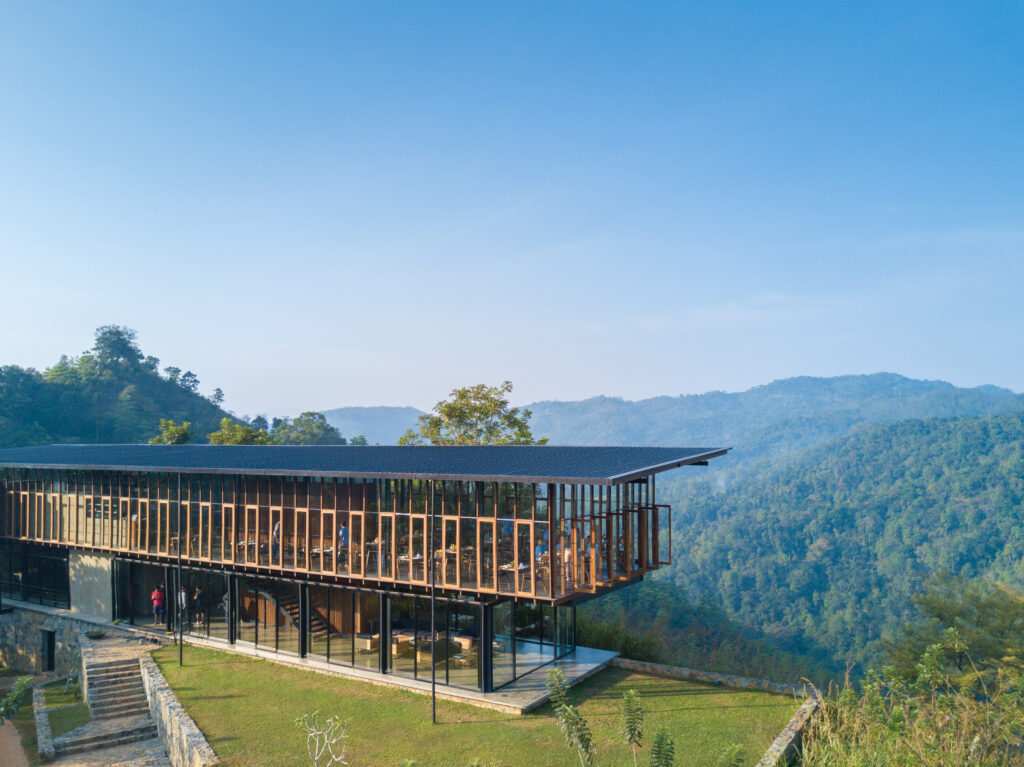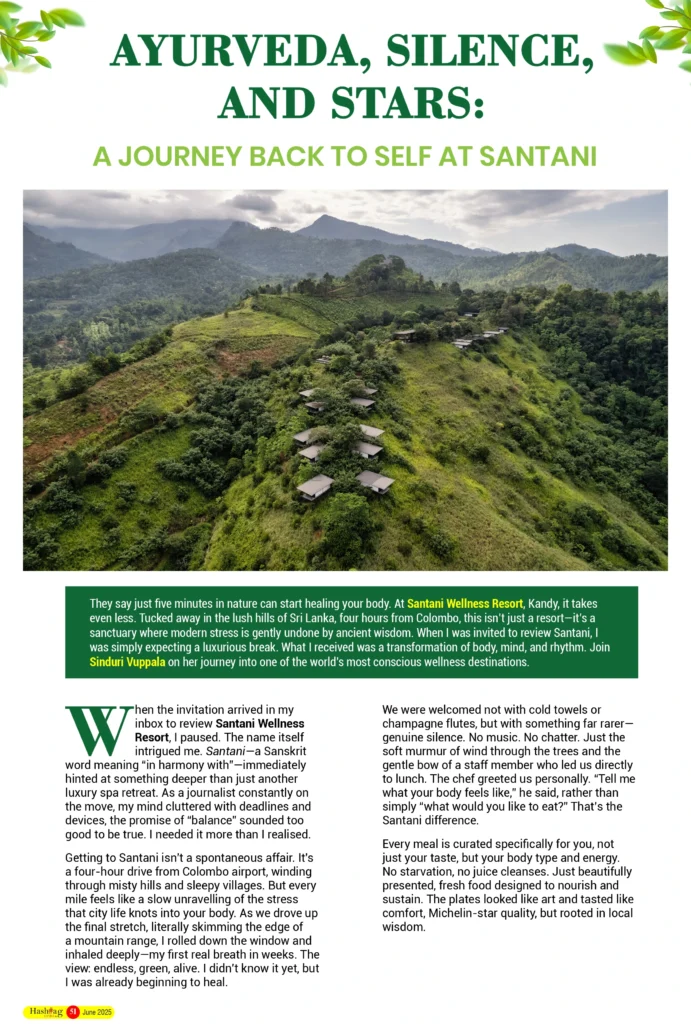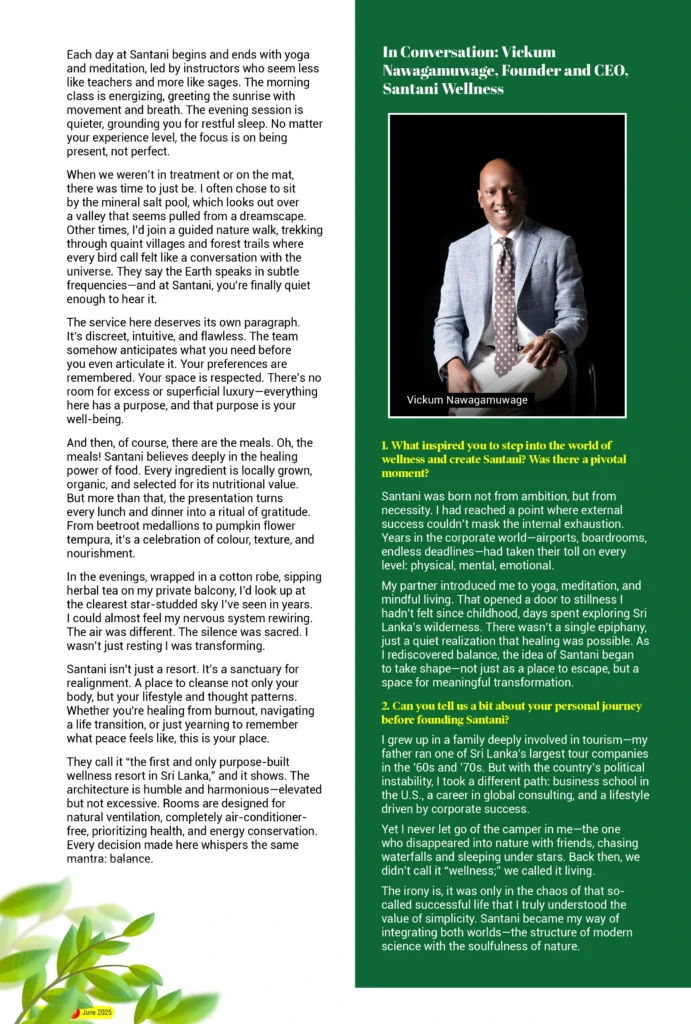They say just five minutes in nature can start healing your body. At SANTANI WELLNESS Resort, Kandy, it takes even less. Tucked away in the lush hills of Sri Lanka, four hours from Colombo, this isn’t just a resort it’s a sanctuary where modern stress is gently undone by ancient wisdom. When I was invited to review Santani, I was simply expecting a luxurious break. What I received was a transformation of body, mind, and rhythm. Join SINDURI VUPPALA on her journey into one of the world’s most conscious wellness destinations.
When the invitation arrived in my inbox to review Santani Wellness Resort, I paused. The name itself intrigued me. Santani a Sanskrit word meaning “in harmony with” immediately hinted at something deeper than just another luxury spa retreat. As a journalist constantly on the move, my mind cluttered with deadlines and devices, the promise of “balance” sounded too good to be true. I needed it more than I realised.
Getting to Santani isn’t a spontaneous affair. It’s a four-hour drive from Colombo airport, winding through misty hills and sleepy villages. But every mile feels like a slow unravelling of the stress that city life knots into your body. As we drove up the final stretch, literally skimming the edge of a mountain range, I rolled down the window and inhaled deeply my first real breath in weeks. The view: endless, green, alive. I didn’t know it yet, but I was already beginning to heal.
We were welcomed not with cold towels or champagne flutes, but with something far rarer genuine silence. No music. No chatter. Just the soft murmur of wind through the trees and the gentle bow of a staff member who led us directly to lunch. The chef greeted us personally. “Tell me what your body feels like,” he said, rather than simply “what would you like to eat?” That’s the Santani difference. Every meal is curated specifically for you, not just your taste, but your body type and energy. No starvation, no juice cleanses. Just beautifully presented, fresh food designed to nourish and sustain. The plates looked like art and tasted like comfort, Michelin-star quality, but rooted in local wisdom.
Santani isn’t a place where you simply check in, it’s where you begin again. After our meal, we met with a resident Ayurvedic doctor, who guided us through a dosha analysis understanding whether I was predominantly vata, pitta, or kapha. Based on this and a brief physical consultation, we were assigned personalised treatments for the coming days. Each therapy, we were told, would help reset the body and mind in line with ancient healing philosophies.

Day One: My wellness journey started with Abhyangam, an oil massage that’s about much more than relaxation. Warm herbal oils, chosen according to my dosha, were rhythmically applied to remove fatigue and restore lymphatic flow. The massage was followed by time in the sauna and steam room, both perched dramatically above the valley below. Watching clouds roll through distant hills while enveloped in the warmth of healing herbs felt like a spiritual experience.
Day Two: I experienced Shirodhara, the slow and continuous pouring of lukewarm oil on the forehead. This ancient treatment is believed to calm the nervous system and release mental tension. I can’t describe it in words, really—it felt like time melted. Like I was floating between dimensions, my overthinking mind was finally silent.
Day Three: Dhanyamla Dhara, a lesser known but profoundly detoxifying ritual, involved fermented medicinal liquids being rhythmically poured over the body. It’s strange at first, yes but deeply rejuvenating. I felt like I was shedding years of stress from my skin.
Each day at Santani begins and ends with yoga and meditation, led by instructors who seem less like teachers and more like sages. The morning class is energizing, greeting the sunrise with movement and breath. The evening session is quieter, grounding you for restful sleep. No matter your experience level, the focus is on being present, not perfect.
When we weren’t in treatment or on the mat, there was time to just be. I often chose to sit by the mineral salt pool, which looks out over a valley that seems pulled from a dreamscape. Other times, I’d join a guided nature walk, trekking through quaint villages and forest trails where every bird call felt like a conversation with the universe. They say the Earth speaks in subtle frequencies and at Santani, you’re finally quiet enough to hear it.
The service here deserves its own paragraph. It’s discreet, intuitive, and flawless. The team somehow anticipates what you need before you even articulate it. Your preferences are remembered. Your space is respected. There’s no room for excess or superficial luxury; everything here has a purpose, and that purpose is your well-being.

And then, of course, there are the meals. Oh, the meals! Santani believes deeply in the healing power of food. Every ingredient is locally grown, organic, and selected for its nutritional value. But more than that, the presentation turns every lunch and dinner into a ritual of gratitude. From beetroot medallions to pumpkin flower tempura, it’s a celebration of colour, texture, and nourishment.
In the evenings, wrapped in a cotton robe, sipping herbal tea on my private balcony, I’d look up at the clearest star-studded sky I’ve seen in years. I could almost feel my nervous system rewiring. The air was different. The silence was sacred. I wasn’t just resting, I was transforming.
Santani isn’t just a resort. It’s a sanctuary for realignment. A place to cleanse not only your body, but your lifestyle and thought patterns. Whether you’re healing from burnout, navigating a life transition, or just yearning to remember what peace feels like, this is your place.
They call it “the first and only purpose-built wellness resort in Sri Lanka,” and it shows. The architecture is humble and harmoniously elevated but not excessive. Rooms are designed for natural ventilation, completely air-conditioner-free, prioritizing health, and energy conservation. Every decision made here whispers the same mantra: balance.
When I finally left Santani, I didn’t just feel rested, I felt reset. Like my body remembered how to breathe again. Like my mind was spacious and open, not just productive. It’s rare to find places that don’t just offer escape, but return. Return to yourself, to the Earth, to that quiet, ancient rhythm that heals us all.
So yes, I went for a review. But what I found was a revival. And I can confidently say: Begin again in one of the greatest places in the world.

In Conversation: Vickum Nawagamuwage, Founder and CEO, Santani Wellness
1. What inspired you to step into the world of wellness and create Santani? Was there a pivotal moment?
Santani was born not from ambition, but from necessity. I had reached a point where external success couldn’t mask the internal exhaustion. Years in the corporate world airports, boardrooms, endless deadlines had taken their toll on every level: physical, mental, emotional.
My partner introduced me to yoga, meditation, and mindful living. That opened a door to stillness I hadn’t felt since childhood, days spent exploring Sri Lanka’s wilderness. There wasn’t a single epiphany, just a quiet realization that healing was possible. As I rediscovered balance, the idea of Santani began to take shape not just as a place to escape, but a space for meaningful transformation.
2. Can you tell us a bit about your personal journey before founding Santani?
I grew up in a family deeply involved in tourism. My father ran one of Sri Lanka’s largest tour companies in the ’60s and ’70s. But with the country’s political instability, I took a different path: business school in the U.S., a career in global consulting, and a lifestyle driven by corporate success.
Yet I never let go of the camper in me, the one who disappeared into nature with friends, chasing waterfalls and sleeping under stars. Back then, we didn’t call it “wellness;” we called it living. The irony is, it was only in the chaos of that so-called successful life that I truly understood the value of simplicity. Santani became my way of integrating both worlds, the structure of modern science with the soulfulness of nature.
3. Santani is known for blending ancient wisdom with modern science. What went into creating that ecosystem?
From the outset, the idea was to strip away excess, not to impress, but to restore. Nature was the cornerstone. We selected a site where the energy is tangible, where silence has depth.
From there, we worked with Ayurvedic doctors, yogis, and medical experts to build a system that is integrative, not prescriptive. The architecture is minimal and open, dissolving the boundary between inside and out. Every element wellness programs, dosha-based treatments, even the saltwater pool is designed to realign people with their natural rhythm. We didn’t want to offer quick fixes. Santani is a space for sustained clarity and reconnection with oneself and with the world.
4. Wellness retreats are booming. What makes Santani stand out?
We don’t follow trends, we resist them. Santani isn’t a wellness theatre; its wellness is rooted in truth. We’re not selling luxury disguised as health. We offer space, mental, emotional, and physical for genuine renewal. Guests come not for pampering, but for a purpose. They find it in our programs, in the misty mountains, and in the silence that invites self-discovery.
Santani isn’t about escaping the world. It’s about re-entering your life with greater awareness. And that’s what brings people back again and again.





























